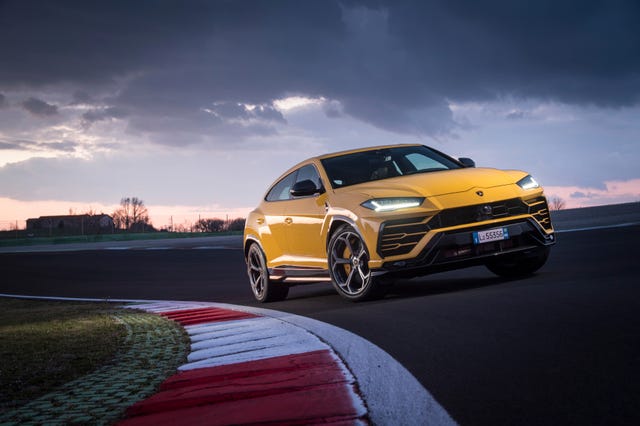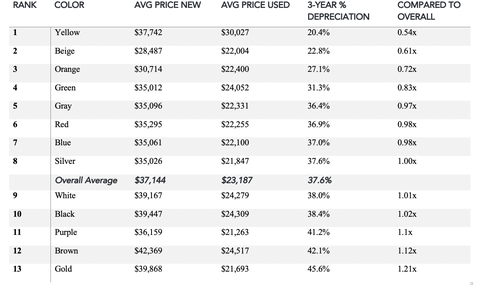If you buy a car fully intending to sell it in three years, you want it to hold its value, right? So how can you help get a better resale value three years down the line? Buy yellow.
“Yellow may not be a widely desired car color, but there are enough people who want yellow, versus the number of yellow new cars being ordered, to make yellow cars more desirable than others on the used market,” said iSeeCars executive analyst Karl Brauer. “In fact, yellow is among the colors with the lowest vehicle share, and is most commonly a color for sports cars and other low-volume vehicles that hold their value relatively well.”
Wait, wasn’t white supposed to be the “safest” car color for depreciation? Turns out, no. White was number nine on the list of 13 colors iSeeCars compiled from a list of 5.6 million new cars and 700,000 used cars bought and sold or traded in between 2017 and 2020. Beige, the second-safest color, only depreciated 22.8 percent in three years. Yellow only 20.4 percent. White dropped 38 percent. Gold was the worst of the 13 colors, plummeting 45.6 percent over three years.
The site iSeeCars.com compared the prices of more than six million new and used cars between 2017 and 2020 and used that data to determine which colors help, hurt, or don’t seem to matter when it comes to vehicle resale value.
“A vehicle’s color is among the primary considerations after shoppers have decided on a make and model,” said Brauer. “With resale value being the single biggest factor in how much a new vehicle ‘costs’ over the course of ownership, consumers should carefully consider their color choice.”
The website said that mainstream colors, including white, black, and silver, are popular because they are seen as the safest colors with the widest appeal. Being seen as and actually being safest, however, are two different things.
“There’s a bit of a self-fulfilling prophecy going on here, with many consumers picking these mainstream colors not because they like them, but because they assume everyone else does,” said Brauer. “This makes white, black, and silver appear to be in high demand, yet our analysis confirms that more obscure colors tend to hold their value better than common and popular colors.”
Vehicle Depreciation by Car Color
Brauer points out that the most common car colors—black, white, silver, gray, red, and blue—are all close to average in terms of depreciation. “Because there are so many of these vehicles in the used car marketplace, buyers can shop around more easily if they’re interested in these colors, reducing the amount of pricing power for dealers,” said Brauer. “This means black, white, and silver are the safe colors to buy if you’re satisfied with average value retention, but not if you’re trying to do better than average.”
Surprisingly, yellow is also the best color for SUVs, sedans and coupes, while beige is best for pickup trucks, red for convertibles, and blue for minivans. Go figure.
There are opposing viewpoints on this, as you might guess. Tyson Jominy, vp of Data and Analytics at J.D. Power, says don't go paint your car yellow just yet.
"Consumers would best be served by selecting the right brand, model and trim," he said. "Color would rank with ownership factors, such as geography, vehicle maintenance, smoking, pets, young children or long commuting miles. (In fact, the worst decision an owner can make is using a vehicle for car sharing, even once, which can take thousands off a trade-in if the VIN turns up as an Uber.)
Jominy went after the study's findings.
"The danger is in relying on averages for an attribute like color, that is not distributed normally across vehicles and segments. Essentially what you are comparing is an extremely small population of flashy colors against very large populations of grayscale colors. A white 911 will be washed by the large availability of white RAV4s and Accords, but a yellow 911 may contribute an outsized share of yellow data. That does not mean a white 911 has 18ppts (percentage points) worse depreciation hit than yellow. We have to isolate a specific vehicle to determine the impact color has on deprecation. How does a yellow F-150 compare to black F-150 or a silver 911 vs a blue 911? Here we find that color may add or subtract a nominal amount at disposal, perhaps up to a couple hundred dollars (heritage or special editions notwithstanding). However, that variance pales in comparison to the ownership factors listed above and would certainly not account for a 25ppts depreciation change from top to bottom, which is very misleading. Put another way, if car companies received a 25ppt better residual value for color, we’d all be driving flashy colored cars.
"If you trade in a vehicle with a flashy color that a dealer knows will be a slow turner, or lot rot, they will likely offer below book value and send it immediately to auction. We know this because yellow is the second slowest turning used vehicle, behind only bronze and just ahead of orange and brown.. Dealers may mark up slow turners considerably to build in potential profit for the incremental interest costs of a much slower sale. That doesn’t mean consumers are paying that advertised price.
"The reality is, buy whatever color you want without worry. The differences are so small at trade-in time and if a dealer doesn’t offer enough on your trade because you have a flashy color, post your car on any national used vehicle sales channel to sell it privately to another consumer who will."
Check out more iSeeCars lists here. And put down that spray gun!
Do you choose your car colors based on retaining resale value, personal preference, or availability? Share you comments with us below.




















